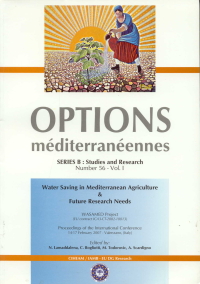| Article précédent | p. 439-451 |
Efficiency of furrow irrigation on sandy soil amended with bentonite in arid and semi arid region
It has been shown that strong correlations exist between water holding capacity and particle size distribution of the soils, especially their clay and fine silt contents. The addition of bentonite to a sandy soil increases water holding capacity and crop yield. Several works showed that a 10 percent dose of bentonite increased the water holding capacity in the average to 170 percent compared to non amended reference soils. Furrow irrigation is the most used technique to irrigate sandy soils related to their high permeability insuring water transfer in soils horizontally as well as vertically. This technique concerns most usual practice of irrigation in Algeria. In this work, we have studied the performance parameters of this type of irrigation on a sandy soil of the plateau of Mostaganem (West-North of Algeria) amended by 5 percent and 15 percent of bentonite in between the optimal dose of 10 percent on an experimental site. The results are discussed in the light of experimental data obtained in the laboratory. This study showed that the percolation losses on water decreased with an increasing dose of bentonite and so the efficiency of water was improved. General considerations are deduced to improve control of furrow irrigation in sandy soils amended with bentonite.
Dans ce travail, nous avons étudié les paramètres de performance de l'irrigation à la raie sur le site d'un sol sableux du plateau de Mostaganem (nord ouest de l'Algérie) amendé par 5 et 15 pour cent de bentonite ajoutée à la dose optimale de 10 pour cent. De fortes corrélations existent entre la réserve hydrique du sol et sa composition en argile et en limons fins. L'addition de bentonite aux sols sableux provoque une augmentation de leur capacité à retenir l'eau et à améliorer la production agricole. Plusieurs travaux montrent que l'apport de 10 pour cent de bentonite, augmente la réserve hydrique d'un sol sableux de 170 pour cent en moyenne par rapport au témoin. L'irrigation à la raie est la plus utilisée dans les sols sableux étant donnée leur grande perméabilité qui assure une bonne mobilité de l'eau aussi bien horizontalement que verticalement. Cette technique couvre l'essentiel des pratiques d'irrigation en Algérie. Les résultats obtenus sont discutés à la lumière d'autres données expérimentales réalisées en laboratoire. Cette étude a permis de constater que les pertes d'eau par percolation ont diminué suite à l'augmentation de la dose d'argile et l'irrigation est plus efficace. Nous déduisons, globalement, que ce type d'amendement pour sols sableux procure un meilleur contrôle des paramètres de performance de l'irrigation à la raie.
- [ Afficher ]
- [ Télécharger ]
- [ Exporter la citation ]
Vous pouvez télécharger la citation au format :
- [ Imprimer ]
-
Mots-clés
ALGERIE, BENTONITE, CONSERVATION DE L'EAU, EFFICACITE, INFILTRATION, IRRIGATION A LA RAIE, RENDEMENT EN EAU, SOL SABLEUX, ZONE ARIDECiter cet article
Benkhelifa M., Daoud Y., Belkhodja M., Tessier D. Efficiency of furrow irrigation on sandy soil amended with bentonite in arid and semi arid region. In : Lamaddalena N. (ed.), Bogliotti C. (ed.), Todorovic M. (ed.), Scardigno A. (ed.). Water saving in Mediterranean agriculture and future research needs [Vol. 1]. Bari : CIHEAM, 2007. p. 439-451. (Options Méditerranéennes : Série B. Etudes et Recherches; n. 56 Vol.I). Proceedings of the International Conference WASAMED Project (EU contract ICA3-CT-2002-10013), 2007/02/14-17, Valenzano (Italy). http://om.ciheam.org/om/pdf/b56_1/00800131.pdf



